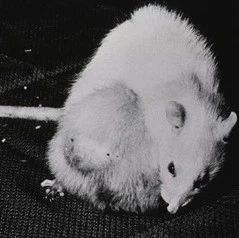很多时候,那些似乎已经被治疗消灭的癌症又会卷土重来。一些科学家将此归罪于所谓的癌症干细胞,它们是癌细胞的一个子集,能够保持休眠状态,从而逃避化疗或放疗,并在几个月或几年后形成新的肿瘤。这种想法一直存在争论,然而,8月1日发表的3篇论文提供了新的证据,表明在某些脑、皮肤和肠道肿瘤中,癌症干细胞确实是肿瘤生长的源头。

癌症干细胞模式有别于认为肿瘤生长机会均等的传统理论,后者相信,任何以及所有的癌性细胞都能够分裂并导致肿瘤的生长及扩散。而癌症干细胞模式则认为,肿瘤生长具有更多的层次,主要由一个能够进行自我复制的细胞子集所驱动,进而生成肿瘤所包含的其他类型的细胞。有关癌症干细胞的最早证据源于上世纪90年代进行的白血病研究,科学家当时发现,只有一小部分癌变的血液细胞能够在小鼠中传播疾病。但是很难确定癌症干细胞是否在其他组织中激发了肿瘤的生长。
在这些新的研究中,3个独立的研究团队利用遗传细胞标记技术追踪了特定细胞在生长的肿瘤内部的增殖情况。比利时布鲁塞尔自由大学的干细胞研究人员Cédric Blanpain表示,这种方法让研究人员看到了“在一个肿瘤的现实生活中到底发生了什么”。他和同事在《自然》杂志网络版上报告说,在小鼠的乳头状瘤(一种皮肤癌的前兆)中,大部分的肿瘤生长来自于一些细胞,后者在某些方面类似于保持皮肤健康的干细胞。
在同样于8月1日发表在《自然》杂志网络版上的第二篇论文中,美国达拉斯市得克萨斯大学西南医学中心(UTSMC)的发育生物学家Luis Parada及其同事报告说,在生有神经胶质瘤(脑癌的一种形式)的小鼠中,肿瘤的生长似乎来源于肿瘤中的一小部分细胞。他们发现,这些细胞在能够消灭大部分癌症的化疗过程中保持了休眠状态,并且一旦药物治疗停止,便能够引发新的肿瘤。
而在8月1日在线发表于《科学》杂志的第三篇论文中,荷兰乌得勒支市Hubrecht研究所的发育生物学家及干细胞研究人员Hugo Snippert、Arnout Schepers、Hans Clevers和他们的同事,利用具有多色肠道的小鼠研究了能够形成肠腺瘤(肠癌的前兆)的细胞类型。这种被科学家昵称为彩纸鼠的啮齿动物携带了能够根据肠道细胞自身来源而将其标注为蓝、绿、红或黄色的遗传标记。研究小组报告说,肠腺瘤由表达了一种名为Lgr5+基因的细胞发展而来,而这种基因也活跃于普通的肠道干细胞中。Snippert说:“这些肿瘤看起来就像是一幅正常组织的漫画。”
并未参与任何一项研究的在UTSMC从事干细胞与癌症研究的Sean Morrison表示,这种细胞追踪技术是检验癌症干细胞模式的正确方法。他说,现在有足够的证据可以相当肯定该模式至少能够解释某些类型的癌症。但是Morrison指出,这些关于乳头状瘤和肠腺瘤的研究着眼于癌症前期的肿瘤。事实上,当Blanpain和同事研究患有鳞状细胞癌(乳头状瘤的一种恶性产物)的小鼠时,他们发现大部分细胞正在积极地分裂,而并非仅仅是一小部分与干细胞类似的细胞。
研究人员相信,搞清哪些癌症可能源于——或仅仅携带了——癌症干细胞是今后更有效治疗的关键。然而,这并不是一项简单的工作。Morrison强调,即便是在患有相同癌症的病人中间,肿瘤的生长也是大相径庭的。尽管如此,Parada认为,肿瘤可能含有癌症干细胞的3个案例意味着将会有更多的此类情况。“我希望它能够支持并促进科学家们”想出如何更好地研究癌症干细胞模式。Parada说:“让我们把这一级别的详细筛查扩展到所有的实体肿瘤上。”

Defining the mode of tumour growth by clonal analysis
Gregory Driessens, Benjamin Beck, Amélie Caauwe, Benjamin D. Simons & Cédric Blanpain
Recent studies using the isolation of a subpopulation of tumour cells followed by their transplantation into immunodeficient mice provide evidence that certain tumours, including squamous skin tumours, contain cells with high clonogenic potential that have been referred to as cancer stem cells (CSCs). Until now, CSC properties have only been investigated by transplantation assays, and their existence in unperturbed tumour growth is unproven. Here we make use of clonal analysis of squamous skin tumours using genetic lineage tracing to unravel the mode of tumour growth in vivo in its native environment. To this end, we used a genetic labelling strategy that allows individual tumour cells to be marked and traced over time at different stages of tumour progression. Surprisingly, we found that the majority of labelled tumour cells in benign papilloma have only limited proliferative potential, whereas a fraction has the capacity to persist long term, giving rise to progeny that occupy a significant part of the tumour. As well as confirming the presence of two distinct proliferative cell compartments within the papilloma, mirroring the composition, hierarchy and fate behaviour of normal tissue, quantitative analysis of clonal fate data indicates that the more persistent population has stem-cell-like characteristics and cycles twice per day, whereas the second represents a slower cycling transient population that gives rise to terminally differentiated tumour cells. Such behaviour is shown to be consistent with double-labelling experiments and detailed clonal fate characteristics. By contrast, measurements of clone size and proliferative potential in invasive squamous cell carcinoma show a different pattern of behaviour, consistent with geometric expansion of a single CSC population with limited potential for terminal differentiation. This study presents the first experimental evidence for the existence of CSCs during unperturbed solid tumour growth.
文献链接:Defining the mode of tumour growth by clonal analysis
A restricted cell population propagates glioblastoma growth after chemotherapy
Jian Chen, Yanjiao Li, Tzong-Shiue Yu, Renée M. McKay, Dennis K. Burns, Steven G. Kernie & Luis F. Parada
Glioblastoma multiforme is the most common primary malignant brain tumour, with a median survival of about one year1. This poor prognosis is due to therapeutic resistance and tumour recurrence after surgical removal. Precisely how recurrence occurs is unknown. Using a genetically engineered mouse model of glioma, here we identify a subset of endogenous tumour cells that are the source of new tumour cells after the drug temozolomide (TMZ) is administered to transiently arrest tumour growth. A nestin-ΔTK-IRES-GFP (Nes-ΔTK-GFP) transgene that labels quiescent subventricular zone adult neural stem cells also labels a subset of endogenous glioma tumour cells. On arrest of tumour cell proliferation with TMZ, pulse-chase experiments demonstrate a tumour re-growth cell hierarchy originating with the Nes-ΔTK-GFP transgene subpopulation. Ablation of the GFP+ cells with chronic ganciclovir administration significantly arrested tumour growth, and combined TMZ and ganciclovir treatment impeded tumour development. Thus, a relatively quiescent subset of endogenous glioma cells, with properties similar to those proposed for cancer stem cells, is responsible for sustaining long-term tumour growth through the production of transient populations of highly proliferative cells.
文献链接:A restricted cell population propagates glioblastoma growth after chemotherapy
Lineage Tracing Reveals Lgr5+ Stem Cell Activity in Mouse Intestinal Adenomas
Arnout G. Schepers, Hugo J. Snippert, Daniel E. Stange, Maaike van den Born, Johan H. van Es, Marc van de Wetering, Hans Clevers
The concept that tumors are maintained by dedicated stem cells, the so-called cancer stem cell hypothesis, has attracted great interest but remains controversial. Studying mouse models, we provide direct, functional evidence for the presence of stem cell activity within primary intestinal adenomas, a precursor to intestinal cancer. By “lineage retracing” using the multicolor Cre-reporter R26R-Confetti, we demonstrate that the crypt stem cell marker Lgr5 (leucine-rich repeat–containing heterotrimeric guanine nucleotide–binding protein–coupled receptor 5) also marks a subpopulation of adenoma cells that fuel the growth of established intestinal adenomas. These Lgr5+ cells, which represent about 5 to 10% of the cells in the adenomas, generate additional Lgr5+ cells as well as all other adenoma cell types. The Lgr5+ cells are intermingled with Paneth cells near the adenoma base, a pattern reminiscent of the architecture of the normal crypt niche.
文献链接:Lineage Tracing Reveals Lgr5+ Stem Cell Activity in Mouse Intestinal Adenomas








